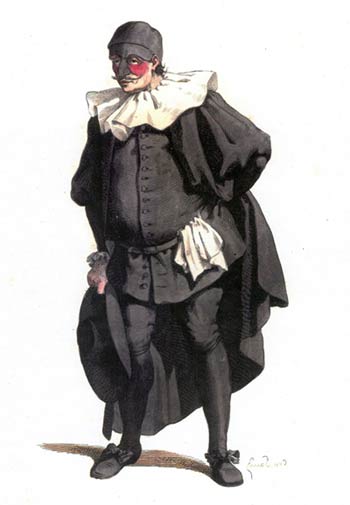The Comedy of Errors was long thought to be Shakespeare’s first play. It is by far his shortest play with what, at first glance, seems like a very simple plot. All the evidence pointed to the fact that he was a new playwright who hadn’t developed fully as writer. However, scholars have since discovered that Comedy was first performed around 1594 (still early on in his career) at the hall of Gray’s Inn likely during Christmastime for an audience of nobleman and royalty. The play’s brevity is due to the fact that it was an after piece– a short, boisterous comedy that completed a night of fun and merry-making typical of the Elizabethan holiday season.
The play was inspired by the great Italian Comedy of the Renaissance (commedia dell’arte) and the Roman comedies of Plautus. Anyone who has spent any time in the Williston Theatre knows that I love commedia dell’arte, the professional theatre troupes that grew out of the Renaissance. Almost all of the comedy we see today is derived, in one way or another, from commedia. These troupes were well-organized and often had women in charge (something that, even now, is a rarity in professional theatre). They roamed the countryside of Europe, creatively subverting the status quo by using improvisation, familiar stock characters, gibberish and broad comedy. Like today’s best stand-up comedians and sketch comedy artists, commedia poked fun at all of the things that were wrong with society. Audiences loved it, the government and the Catholic church did not.

Because commedia is the basis for all Western comedy (especially Shakespeare’s comedies, which were heavily influenced by commedia), I invited local commedia expert Brianna Sloane to lead a physical comedy workshop with the cast of The Comedy of Errors. Ms. Sloane is the artistic director of Theatre Truck, which crafts “mobile and site-specific theatre sustainably and playfully.” Her current piece, The Water Project, is an interactive and immersive piece about the communities that were flooded to create the Quabbin Reservoir and will be performed at the Swift RIver Historical society later this month. She has studied commedia dell’arte at the Accedemia dell’Arte in Florence, Italy and holds an MFA in Directing from UMass Amherst. Her vibrant energy kept our actors engaged for the duration of the two-hour workshop!
After a terrific warm-up that involved lots of moving and shouting (like any good theatre warm up!), our actors got a chance to explore the major stock characters of commedia one at a time. Starting with the Zanni (the lowest of the servants who are struggling for basic survival) and all the way up to the Lovers, the cast could make connections between their characters and their commedia counterparts. The Comedy of Errors is incredibly physical. Without a basis to create the bodies of our characters, we would end up with a play that is boring and doesn’t stay true to Shakespeare’s intentions. We look forward to applying all of the wonderful and wacky things we learned in our workshop to the rehearsal process as we bring the show to life. When you come see the play, try and see which commedia character influenced each actor! See below to learn more about some of the stock characters of commedia.
ARLECHINO

COLUMBINA

PANTALONE

IL DOTTORE

CAPITANO

INNAMORATI (THE LOVERS)

To learn more about Theatre Truck visit http://www.thetheatretruck.com/
Tickets for The Comedy of Errors will go on sale in early October. Visit http://williston.com/theater for more information.

